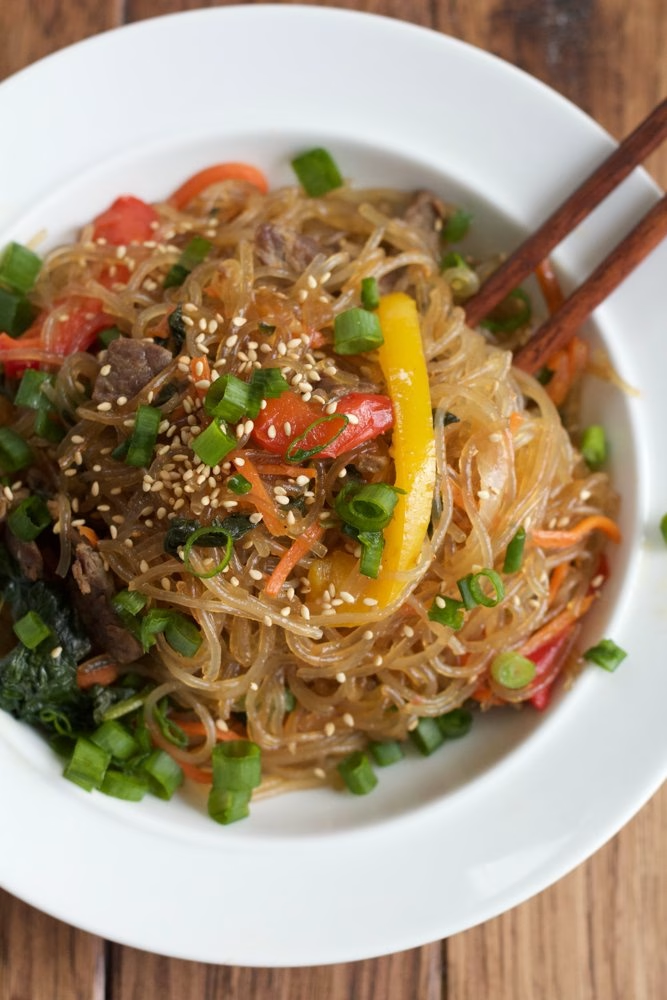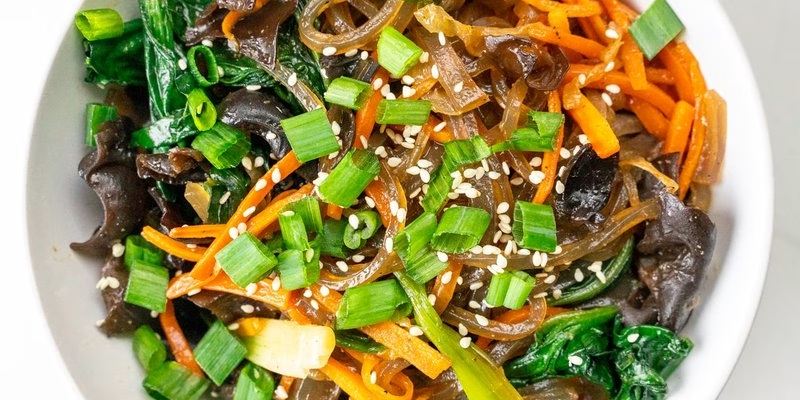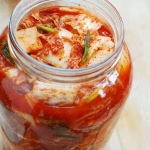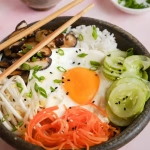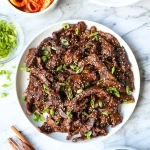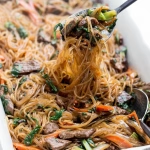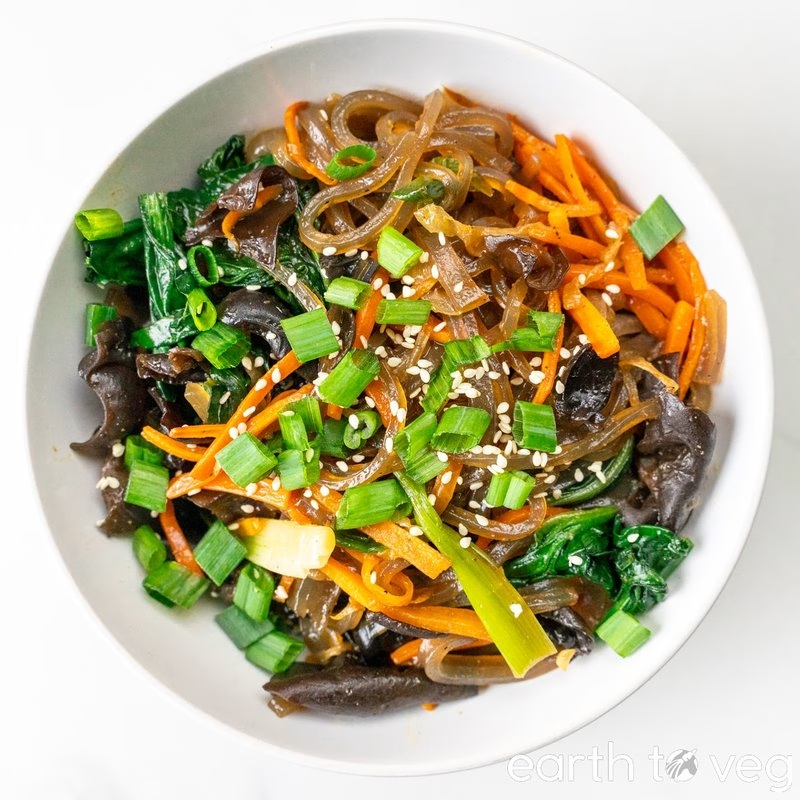
Have you ever tasted a dish that feels like a warm hug? Meet Japchae Bap (Japchae With Rice), the ultimate comfort food of Korean cuisine! It combines the iconic stir-fried glass noodles with rice, creating a delightful fusion that’s not only filling but also bursting with flavor. Originating from Korea, Japchae has been a beloved dish for centuries, often served during celebrations and special occasions.
This recipe uniquely pairs traditional Japchae with nutritious rice, making it a complete meal that’s great for any day of the week. In this article, you will learn how to make Japchae Bap (Japchae With Rice) at home using fresh ingredients. We’ll explore the key ingredients, provide step-by-step instructions, offer pro tips, and answer some common questions. Ready to dive into this culinary adventure?
Ingredients
| Ingredient | Measurement | Description |
|---|---|---|
| Sweet potato noodles (dangmyeon) | 200g | These chewy noodles are the star of Japchae, absorbing flavors beautifully. |
| Rice | 2 cups | Using steamed rice adds a hearty texture to the dish. |
| Beef (or tofu for a vegan option) | 150g | Thinly sliced, this adds protein and richness to your Japchae Bap. |
| Carrots | 1 medium | Sliced into thin strips, they bring a vibrant color and sweetness. |
| Spinach | 1 cup | Fresh spinach provides a nutritious boost and a lovely green color. |
| Soy sauce | 3 tablespoons | The main seasoning for depth and umami flavor in your homemade Japchae Bap. |
| Garlic | 2 cloves, minced | Fresh garlic enhances the aroma and depth of flavor in Japchae Bap. |
| Sesame oil | 1 tablespoon | This oil adds a nutty finish, elevating the dish’s overall flavor profile. |
Step-by-Step Instructions
- Prepare the Ingredients: Start by soaking the sweet potato noodles in warm water for about 30 minutes until softened. Meanwhile, chop your fresh vegetables like carrots and spinach, and thinly slice the beef or tofu for an authentic Japchae Bap (Japchae With Rice) taste.
- Cook the Base: In a large skillet, heat a splash of sesame oil over medium heat. Add minced garlic, sautéing until fragrant, then toss in the beef or tofu. Cook until browned, adding a splash of soy sauce for flavor.
- Add the Vegetables: Stir in the carrots and spinach, letting them wilt down for about 3-4 minutes. Incorporate the soaked noodles, mixing everything well and adding more soy sauce as needed. Stir-fry for an additional 5-7 minutes until everything is hot and well-combined.
- Serve with Rice: Prepare a bowl of steamed rice, then top it generously with your delicious Japchae Bap. Make sure to drizzle a bit of sesame oil on top for that extra touch!
Pro Tips
- For added texture, feel free to toss in mushrooms or bell peppers!
- Let the noodles soak long enough; it helps them absorb flavors better.
- Use leftover vegetables you have in your fridge – Japchae Bap is versatile!
- If possible, use a wok – it heats up faster and cooks evenly.
- Experiment with different proteins like chicken or shrimp for variety!
Nutritional Information
| Nutrient | Per Serving |
|---|---|
| Calories | 400 |
| Protein | 24g |
| Carbohydrates | 60g |
| Saturated Fats | 2.5g |
| Fiber | 4g |
| Cholesterol | 70mg |
| Sugars | 3g |
| Fat | 10g |
FAQs
What is the best way to store Japchae Bap (Japchae With Rice)?
Store any leftovers in an airtight container in the fridge for up to three days. Simply reheat in a pan or microwave before serving.
Can Japchae Bap (Japchae With Rice) be made vegan or gluten-free?
Absolutely! Use tofu instead of beef for a vegan option and swap regular soy sauce with gluten-free soy sauce or tamari.
What are the best side dishes to serve with Japchae Bap (Japchae With Rice)?
Classic Korean side dishes like kimchi or pickled radish pair beautifully with Japchae Bap. You can also serve it with a light cucumber salad!
How long does it take to prepare Japchae Bap (Japchae With Rice)?
The total preparation and cooking time is about 45 minutes. It’s a quick and delightful meal!
Can I freeze Japchae Bap (Japchae With Rice) for later?
Yes, you can freeze it! Just make sure to let it cool completely before placing it in a freezer-safe container. It will last for about a month.
What type of rice is best for Japchae Bap (Japchae With Rice)?
Short-grain or medium-grain rice works best, as it tends to be stickier and complements the noodles well.
Can I add more vegetables to Japchae Bap (Japchae With Rice)?
Definitely! Feel free to add bell peppers, zucchini, or any vegetables you have on hand for a colorful dish.
Is Japchae Bap (Japchae With Rice) spicy?
It’s typically not spicy unless you add chili paste or fresh chili. Adjust the seasoning based on your heat preference!
To sum it all up, Japchae Bap (Japchae With Rice) is a hearty, versatile dish that’s easy to make at home. With its unique textures and flavors, it’s sure to become a family favorite! So, roll up your sleeves, gather your ingredients, and give this delicious recipe a whirl. Don’t forget to let us know your experiences and any variations you tried in the comments below. Happy cooking!
